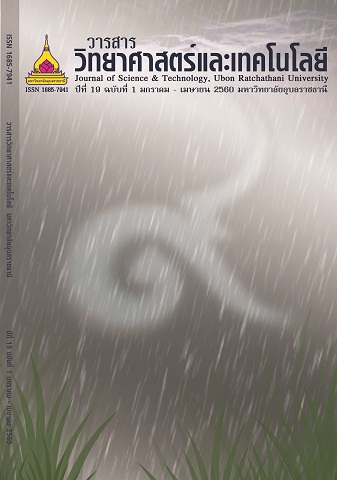ชีววิทยาการสืบพันธุ์และปัจจัยที่มีผลต่อความสมบูรณ์เพศของหอยโข่งพื้นเมือง (Pila ampullacea Linnaeus, 1758) ในพื้นที่นาข้าวอำเภอศรีเมืองใหม่ จังหวัดอุบลราชธานี
Main Article Content
บทคัดย่อ
ปัจจุบันหอยโข่ง (Pila ampullacea Linnaeus, 1758) ในธรรมชาติลดจำนวนลงอย่างมาก เนื่องจากการเปลี่ยนแปลงของสภาพแวดล้อมและผลกระทบจากมนุษย์ การศึกษาครั้งนี้มีวัตถุประสงค์เพื่อศึกษาข้อมูลทางชีววิทยาการสืบพันธุ์ เพื่อเป็นแนวทางสำหรับการนำหอยโข่งจากธรรมชาติมาเลี้ยงให้เป็นพ่อแม่พันธุ์ในโรงเพาะฟัก โดยรวบรวมตัวอย่างเดือนมกราคม-ธันวาคม พ.ศ. 5528 ในพื้นที่นาข้าว อำเภอศรีเมืองใหม่ จังหวัดอุบลราชธานี จากการศึกษาพบหอยโข่งในช่วงเดือนเมษายน-พฤศจิกายน และไม่พบตัวอย่างในธรรมชาติในเดือนธันวาคม-มีนาคม หอยโข่งเพศผู้จะมีขนาดตัวและน้ำหนักน้อยกว่าเพศเมีย อัตราส่วนเพศผู้และเพศเมียเท่ากับ 1:1.15 ดัชนีความสมบูรณ์เพศของเพศผู้มีการพัฒนาก่อนเข้าสู่ช่วงฤดูฝน (พฤษภาคม 8.09±1.6 % และมิถุนายน 8.08±2.79 %) ดัชนีความสมบูรณ์เพศของเพศเมียเพิ่มขึ้นในช่วงเดือนเมษายน (6.23±4.54 %) ถึงกรกฎาคม (12.43±11.83 %) คุณภาพน้ำและคุณภาพดินในพื้นที่นาข้าวที่มีความเหมาะสมต่อการดำรงชีวิตของหอยโข่ง พบว่า ความสมบูรณ์เพศของหอยโข่งมีความสัมพันธ์กับความชื้นของดินและความหนาแน่นของหอยโข่ง จากการศึกษาอวัยวะสืบพันธุ์ด้วยวิธีทางเนื้อเยื่อวิทยา พบเซลล์ไข่ 3 ระยะ (ช่วงยังไม่พัฒนา ช่วงกำลังพัฒนา และ ช่วงพร้อมผสมพันธุ์) ในช่วงฤดูผสมพันธุ์ (มิถุนายน-สิงหาคม) จะพบระยะที่กำลังพัฒนาและระยะที่พร้อมผสมพันธุ์จำนวนมาก ในขณะที่เซลล์สืบพันธุ์เพศผู้แบ่งได้เป็น 4 ระยะ (Spermatogonia, spermatocyte, spermatid และ spermatozoa) ช่วงฤดูผสมพันธุ์ (พฤษภาคม-กันยายน) พบเซลล์ spermatid และ spermatozoa จำนวนมาก
Study on Reproductive Biology and Some Relating Factors on Sexual Maturation of Thai Native Apple Snail (Pila ampullacea Linnaeus, 1758) in the Rice Field Si Muang Mai, Ubon Ratchathani Province
Currently, the environmental changes and human activities may affect on Thai apple snail (Pila ampullacea Linneaus, 1758). The objectives of this study were to determine reproductive biology of Thai apple snail and some relating factors for domesticating in the captivity. Thai apple snail samples were collected annually during January-December 2015 in the rice field area of Si Muang Mai, Ubon Ratchathani province. The results revealed that snail samples were found only in April to November, while no sample was in December to March. The total body weight, body weight, shell length, and shell width of male snails were lower than female. The sex ratio of male and female was 1:1.5. The increasing gonadosomatic index (GSI) of male was found before the rainy season (May-Jun = 8.09±1.6, and 8.08±2.79 respectively), while GSI of female accelerated from April (6.23±4.54 %) to July (12.43±11.83 %). Water and soil quality revealed optimal level for aquatic animals, including Thai apple snail. With Principle component analysis (PCA), GSI related significantly with snail density and soil moisture. The histological studies of reproductive organs revealed that oocytes can be divided into 3 stages (immature, developing and mature stage). The mature stage of oocytes were detected in spawning season (June-August), while sex cell of male composed of 4 stages (Spermatogonia, spermatocyte, spermatid and spermatozoa). Spermatozoa was found in longer period (May-September).
Article Details
บทความที่ได้รับการตีพิมพ์เป็นลิขสิทธิ์ของ วารสารวิทยาศาสตร์และเทคโนโลยี มหาวิทยาลัยอุบลราชธานี
ข้อความที่ปรากฏในบทความแต่ละเรื่องในวารสารวิชาการเล่มนี้เป็นความคิดเห็นส่วนตัวของผู้เขียนแต่ละท่านไม่เกี่ยวข้องกับมหาวิทยาลัยอุบลราชธานี และคณาจารย์ท่านอื่นๆในมหาวิทยาลัยฯ แต่อย่างใด ความรับผิดชอบองค์ประกอบทั้งหมดของบทความแต่ละเรื่องเป็นของผู้เขียนแต่ละท่าน หากมีความผิดพลาดใดๆ ผู้เขียนแต่ละท่านจะรับผิดชอบบทความของตนเองแต่ผู้เดียว


